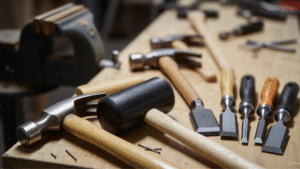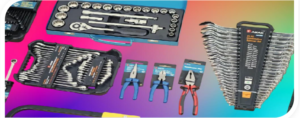When we think about modern vehicles, our minds often jump to high-tech diagnostic equipment, computerized systems, and advanced robotics on the assembly line. Yet, despite all this innovation, one essential element remains at the heart of the automotive industry: hand tools. But what are hand tools exactly, and why do they play such a vital role in automotive work today?
What Are Hand Tools?
Before diving into their role in the automotive world, let’s define what are hand tools. Simply put, hand tools are manually operated devices used to perform a wide range of tasks, from tightening bolts to prying apart components. Unlike power tools, they rely solely on human effort and precision. Examples include wrenches, screwdrivers, pliers, hammers, sockets, and ratchets.
These tools may seem basic, but they form the backbone of automotive maintenance, repair, and assembly. They offer a level of control, versatility, and tactile feedback that power tools can’t always replicate, which is why every mechanic’s toolbox is stocked with an array of trusted hand tools.
The Backbone of Automotive Repair and Maintenance
The automotive industry is a vast network encompassing design, manufacturing, repair, and restoration. At every stage, hand tools are indispensable.
- Precision and Control
Cars today are complex machines with tight tolerances and intricate components. Many jobs require a delicate touch that only hand tools can provide. For instance, when working on engine internals, mechanics often need torque wrenches to apply precise force to bolts to avoid over-tightening. Similarly, small screwdrivers are essential for tasks like replacing dashboard electronics or sensors.
- Accessibility
Certain areas under the hood or beneath the chassis are cramped and difficult to reach. Flexible hand tools like offset wrenches, ratcheting wrenches, or slim screwdrivers allow technicians to work efficiently in tight spaces where bulky power tools simply won’t fit.
- Versatility
Unlike many specialized power tools, hand tools can adapt to a wide range of tasks. A simple socket set can be used to remove and install fasteners on countless parts, from wheels and brakes to suspension systems. Pliers, meanwhile, can grip, twist, cut, or bend wires and cables — a true multi-purpose hero.
Essential Hand Tools in the Automotive Industry
Automotive professionals rely on a core set of hand tools that cover most maintenance and repair scenarios. Here are some must-haves:
- Wrenches: Combination wrenches, adjustable wrenches, and torque wrenches are vital for loosening and tightening nuts and bolts.
- Socket Sets: Ratchets and sockets of various sizes help mechanics tackle fasteners in confined spaces.
- Screwdrivers: Flathead and Phillips screwdrivers are staples for tasks like removing panels or securing electrical connections.
- Pliers: From needle-nose to locking pliers, these tools handle gripping, bending, and cutting jobs.
- Hammers and Mallets: Sometimes, a gentle tap — or a firm whack — is needed to loosen stuck components.
- Pry Bars: Helpful for removing stubborn parts or aligning pieces during assembly.
Supporting Safety and Quality
Proper hand tool use doesn’t just make work easier; it also ensures safety and quality. Using the right tool for the right job reduces the risk of damage to vehicle components and minimizes accidents. For example, using a torque wrench guarantees that critical fasteners like cylinder head bolts are tightened to manufacturer specifications, preventing catastrophic failures.
Additionally, hand tools help maintain a clean work environment. Tools like picks, scrapers, and brushes are vital for removing grime and debris, ensuring that replacement parts fit correctly and perform as intended.
Hand Tools in Automotive Manufacturing
While many imagine robots doing most of the work in car factories, hand tools still play an important role on the assembly line. Technicians perform quality checks, make adjustments, and fix last-minute issues using manual tools. In custom or low-volume production, skilled workers rely heavily on hand tools to assemble parts that require human finesse.
Hand Tools and Modern Automotive Technology
As vehicles become increasingly sophisticated, new hand tools continue to emerge. Hybrid and electric vehicles, for example, require insulated tools to protect technicians from high-voltage systems. Specialized hand tools help access sensors, modules, and batteries that weren’t common a few decades ago.
Even with the rise of diagnostic scanners and software, once a problem is identified, hand tools are what make the actual repairs possible.
Choosing Quality Hand Tools
Not all hand tools are created equal. In the automotive world, durability and precision matter. Professionals invest in high-quality tools made from tough materials like chrome vanadium steel. Ergonomic designs reduce strain during long workdays, and lifetime warranties provide peace of mind. After all, these tools endure daily wear and tear in demanding shop environments.
Hand Tools and the Human Element
At its core, the continued importance of hand tools highlights an essential truth about the automotive industry: the human element can’t be replaced. Even as cars get smarter, skilled technicians remain crucial. Their expertise, combined with a trusty set of hand tools, keeps vehicles running safely and efficiently.
Final Thoughts
So, what are hand tools in the context of the automotive industry? They’re more than simple pieces of metal — they’re extensions of a mechanic’s skill and experience. They provide the precision, adaptability, and control needed to keep vehicles in top shape, from routine oil changes to complex engine rebuilds.
As technology advances, the tools may evolve, but the need for well-crafted, reliable hand tools will never disappear. Whether you’re an industry veteran, an apprentice mechanic, or a DIY car enthusiast, understanding and appreciating the role of hand tools is essential. After all, behind every smoothly running vehicle is a skilled technician — and a well-stocked toolbox.








